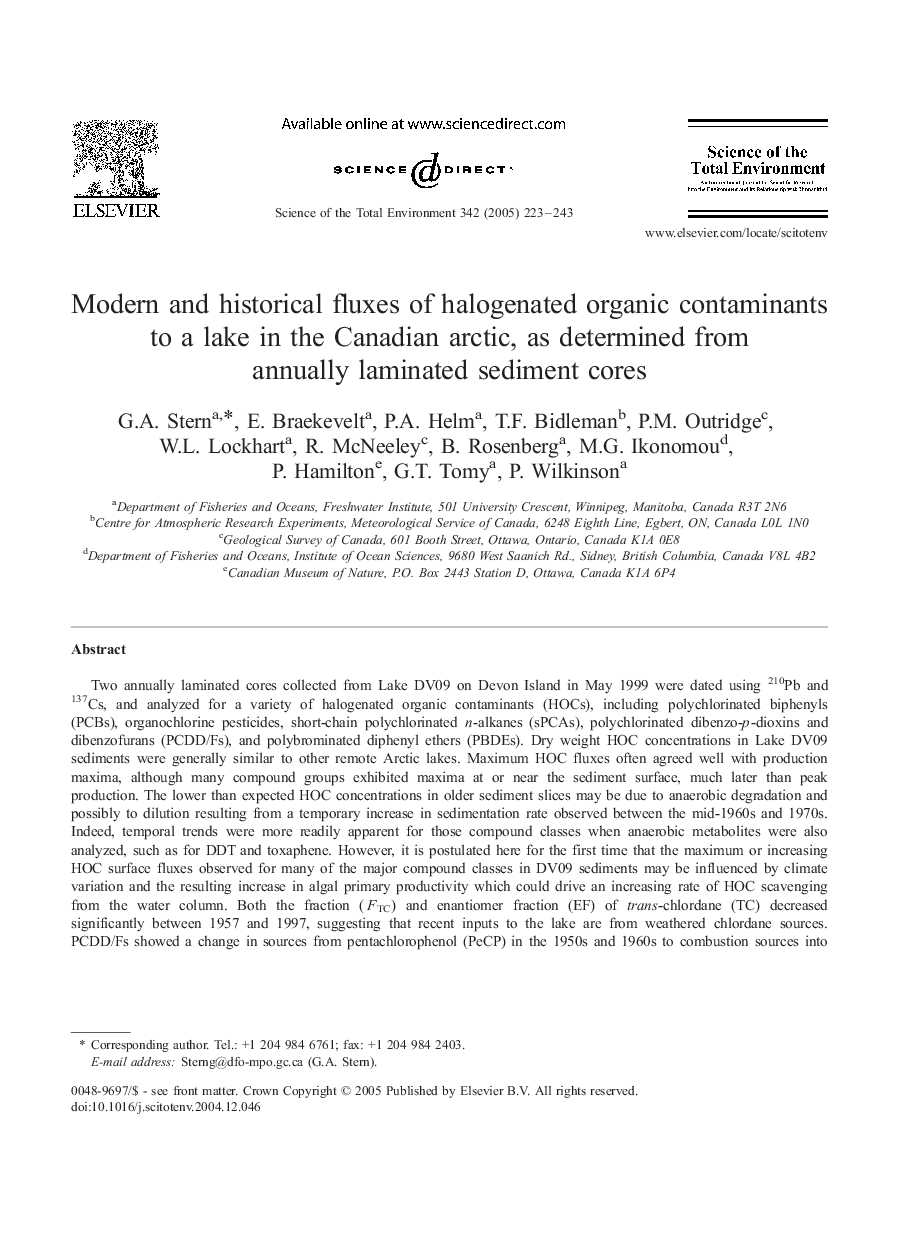| کد مقاله | کد نشریه | سال انتشار | مقاله انگلیسی | نسخه تمام متن |
|---|---|---|---|---|
| 10110871 | 1619996 | 2005 | 21 صفحه PDF | دانلود رایگان |
عنوان انگلیسی مقاله ISI
Modern and historical fluxes of halogenated organic contaminants to a lake in the Canadian arctic, as determined from annually laminated sediment cores
دانلود مقاله + سفارش ترجمه
دانلود مقاله ISI انگلیسی
رایگان برای ایرانیان
کلمات کلیدی
موضوعات مرتبط
علوم زیستی و بیوفناوری
علوم محیط زیست
شیمی زیست محیطی
پیش نمایش صفحه اول مقاله

چکیده انگلیسی
Two annually laminated cores collected from Lake DV09 on Devon Island in May 1999 were dated using 210Pb and 137Cs, and analyzed for a variety of halogenated organic contaminants (HOCs), including polychlorinated biphenyls (PCBs), organochlorine pesticides, short-chain polychlorinated n-alkanes (sPCAs), polychlorinated dibenzo-p-dioxins and dibenzofurans (PCDD/Fs), and polybrominated diphenyl ethers (PBDEs). Dry weight HOC concentrations in Lake DV09 sediments were generally similar to other remote Arctic lakes. Maximum HOC fluxes often agreed well with production maxima, although many compound groups exhibited maxima at or near the sediment surface, much later than peak production. The lower than expected HOC concentrations in older sediment slices may be due to anaerobic degradation and possibly to dilution resulting from a temporary increase in sedimentation rate observed between the mid-1960s and 1970s. Indeed, temporal trends were more readily apparent for those compound classes when anaerobic metabolites were also analyzed, such as for DDT and toxaphene. However, it is postulated here for the first time that the maximum or increasing HOC surface fluxes observed for many of the major compound classes in DV09 sediments may be influenced by climate variation and the resulting increase in algal primary productivity which could drive an increasing rate of HOC scavenging from the water column. Both the fraction (FTC) and enantiomer fraction (EF) of trans-chlordane (TC) decreased significantly between 1957 and 1997, suggesting that recent inputs to the lake are from weathered chlordane sources. PCDD/Fs showed a change in sources from pentachlorophenol (PeCP) in the 1950s and 1960s to combustion sources into the 1990s. Improvements in combustion technology may be responsible for the reducing the proportion of TCDF relative to OCDD in the most recent slice.
ناشر
Database: Elsevier - ScienceDirect (ساینس دایرکت)
Journal: Science of The Total Environment - Volume 342, Issues 1â3, 15 April 2005, Pages 223-243
Journal: Science of The Total Environment - Volume 342, Issues 1â3, 15 April 2005, Pages 223-243
نویسندگان
G.A. Stern, E. Braekevelt, P.A. Helm, T.F. Bidleman, P.M. Outridge, W.L. Lockhart, R. McNeeley, B. Rosenberg, M.G. Ikonomou, P. Hamilton, G.T. Tomy, P. Wilkinson,